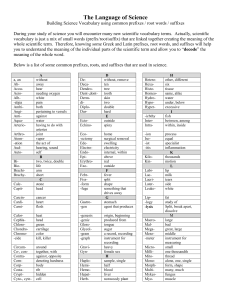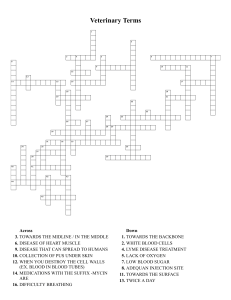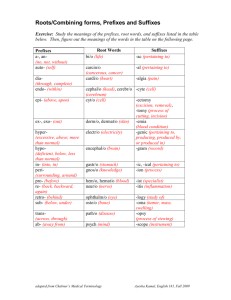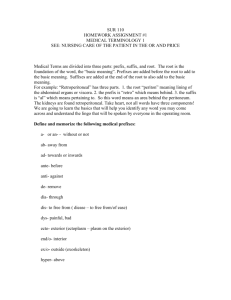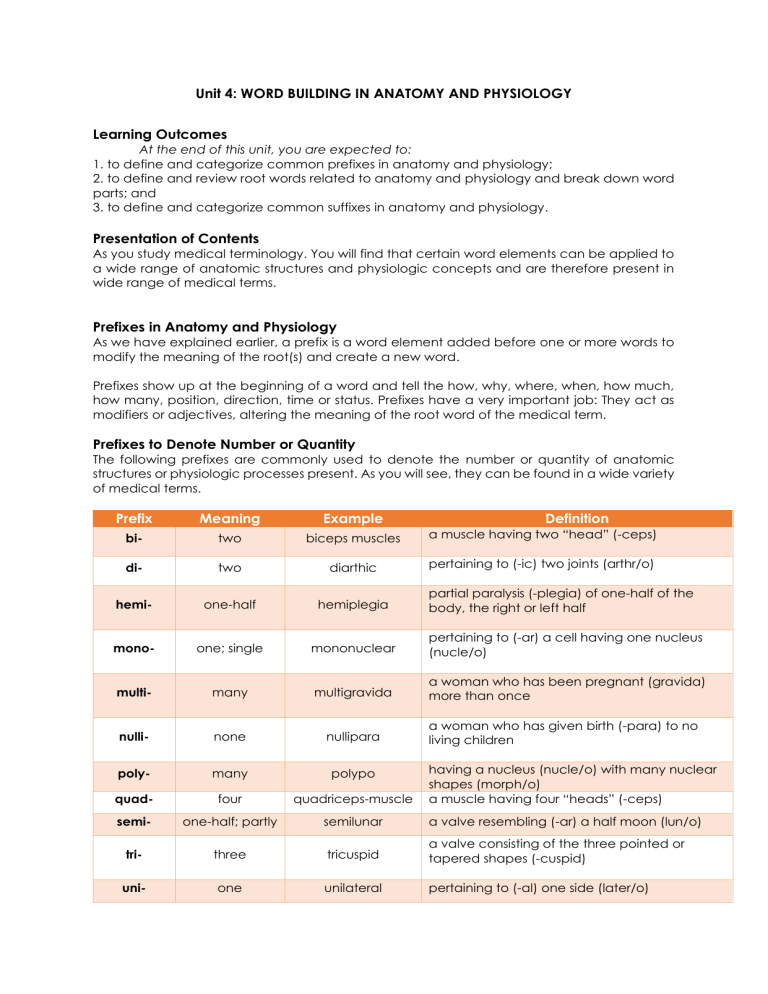
Unit 4: WORD BUILDING IN ANATOMY AND PHYSIOLOGY Learning Outcomes At the end of this unit, you are expected to: 1. to define and categorize common prefixes in anatomy and physiology; 2. to define and review root words related to anatomy and physiology and break down word parts; and 3. to define and categorize common suffixes in anatomy and physiology. Presentation of Contents As you study medical terminology. You will find that certain word elements can be applied to a wide range of anatomic structures and physiologic concepts and are therefore present in wide range of medical terms. Prefixes in Anatomy and Physiology As we have explained earlier, a prefix is a word element added before one or more words to modify the meaning of the root(s) and create a new word. Prefixes show up at the beginning of a word and tell the how, why, where, when, how much, how many, position, direction, time or status. Prefixes have a very important job: They act as modifiers or adjectives, altering the meaning of the root word of the medical term. Prefixes to Denote Number or Quantity The following prefixes are commonly used to denote the number or quantity of anatomic structures or physiologic processes present. As you will see, they can be found in a wide variety of medical terms. Prefix Meaning Example Definition bi- two biceps muscles a muscle having two “head” (-ceps) di- two diarthic pertaining to (-ic) two joints (arthr/o) hemi- one-half hemiplegia mono- one; single mononuclear pertaining to (-ar) a cell having one nucleus (nucle/o) multi- many multigravida a woman who has been pregnant (gravida) more than once nulli- none nullipara a woman who has given birth (-para) to no living children poly- many polypo quad- four quadriceps-muscle semi- one-half; partly semilunar a valve resembling (-ar) a half moon (lun/o) tri- three tricuspid a valve consisting of the three pointed or tapered shapes (-cuspid) uni- one unilateral pertaining to (-al) one side (later/o) partial paralysis (-plegia) of one-half of the body, the right or left half having a nucleus (nucle/o) with many nuclear shapes (morph/o) a muscle having four “heads” (-ceps) Prefixes to Describe Normal Function The following prefixes are commonly used to describe normal anatomic structures and physiologic process. As you will see, some of these prefixes are used to indicate normal functioning of a particular organ, while others are used to compare two or more structures of processes. Prefix Meaning Example Definition a muscle that draws a limb (-ductor) away from the body ab- away from abductor ad- toward; near adrenal pertaining to (-al) a structure located near the kidney (ren/o) ante- before (in time); forward anteversion forward tilting or turning (-version) of an organ from its usual position contra- against; opposite side contralateral pertaining to (-al) something on the opposite side (later/o) of the body dia- through diarrhea discharge (-rrhea) of abundant, watery feces through the anus dis- apart; away from dislocate ec- out; away from ectopic em- in; inside empyema en- in; surrounded by endemic endo- inside; within endometrium epi- on; over; above; outer epidermis ex- out; away from exhale exo- out; away from exocrine hypo- under hypothalamus inter- between; interstitial to move (-locate) a structure away from its usual position, as in dislocating a bone from its joint pertaining to (-ic) a structure out of place (top/o) a condition (-ema) characterized by the presence of pus (py/o) inside a body cavity, usually the chest cavity pertaining to (-ic) something that occurs in people (dem/o) in a particular geographic region the structure or tissue (-um) lining the inside of the uterus (metri/o) noun (-is) signifying the outer layer of skin (derm/o) to breathe (-hale) out secreting (-crine) to the outside surface of an organ rather than into the blood the gland located under the thalamus gland (thalamus) pertaining to (-al) the space (stiti/o) between tissue cells Commonly Used Prefixes to Denote Direction or Location in Time In anatomy and physiology, the location of one anatomic structure I typically described by comparing its position to that of another structure; similarly, the time of one physiologic process is often described in comparison to the occurrence of another. The prefixes listed below are commonly used for this purpose and are found in numerous terms pertaining to anatomy and physiology. Prefix Meaning Example intra- within; inside intravenous ipsi- same; same side ipsilateral para- beside; beyond parathyroid per- through percutaneous peripostpreprimiproretro- around; surrounding after (in time or place) before (in time or place) first in front of; prolapsed before (in time) backward; behind pericardium postpartum prenatal primigravida lapse retroversion sub- under; beneath subcutaneous trans- through; across transurethral Definition pertaining to (-ous) a process occurring inside a vein (ven/o) pertaining to (-al) something on the same side (later/o) of the body the glands located beside the thyroid gland (thyroid) gland pertaining to (-ous) a process occurring through the skin (cutane/o) the structure or tissue (-um) that surrounds the heart (cardi/o) after labor or childbirth (-partum) pertaining to (-al) the time before birth (nat/o) a woman who is pregnant (-gravida) for the first time sinking of an organ to a location in front of its usual position backward tilting or turning (-version) of an organ from its usual position pertaining to (-ous) a process occurring below the skin (cutane/o) pertaining to (-al) a process occurring through the (urethra/o) Review of Common Prefixes Keep the other word part functions in mind when dealing with prefixes. The combining form or root, as explained in the previous unit, specifies the body part. The suffix, always at the end of a word, usually indicates a procedure, condition or disease. When all three work together, they make one powerful word. Let’s review the most common prefixes in simple, easy-to-memorize alphabetical order. Later in the chapter, we go over how theses prefixes fit into everyday medical life and language. A-E Prefixes o o o o o o o o A-, an-: Lack of, without, not Ab-: Away from, take away Ad-: Towards or to, near Ambi-, ambo-: Both Amphi-: Double, both sides Ana-: Up, apart Ante-: Before, in front of, or forward Anti-: Opposing or against o o o o o o o o o o o o o o o o o o o o o Ap-, apo-: Separated or derived from Aut-, auto-: Self, by yourself Bi-: Double, two, twice, both Brady-: Slow; most often refers to heart rhythm/rate Brachy-: short Cata-: Lower, down, against Circum-: Around Co-, con-, com-: Together or with Contra-: Against or opposed to De-: Down or from Di-: Twice or two Dia-: Through, apart, across, between Dis-: Apart from or free from Dys-: Bad, painful, difficult E-, ec-, ex-: From, away from, out of Ect,- exo-, ecto-: Outside, outer, on Em-, en-: In End-, endo-, ent-, ento-: Within or inner Epi-, ep-: Upon, over, or on Eu-: Normal Extra-, extro-: Beyond, outside of, or outward Be on the lookout for prefixes that sound similar but mean slightly different things, such as aband ad-, ambi- and amphi-, dis- and dys-. F-J Prefixes o o o o o o o o Hemi-, semi-: Half, half of Hyper-: Above, excessive, beyond Hyp-, hypo-: Below, beneath, deficient Im-, in-: Into, in, within Infra-: Below or beneath Inter-: Between Intra-: Within, inside Intro-: Into or within Infra-, inter-, and intra- are always mixed up and used inappropriately. K-O Prefixes o o o o o o o o o Macro-: Large Mal-: Bad Mes-, meso-: Middle Meta-: Beyond or changing Micro-, micr-: Tiny, small Mono-, uni-: One Mult-, multi-: Many, multiple Neo-: New or recent Oligo-: Scanty If you can’t recall the meaning of a prefix, try putting into everyday English context. For example, you might remember the meaning of macro- by thinking about the word macroeconomics, which is about economics on a large scale. P-Z Prefixes o o o o o o o o o o o o o o o o o o o o Pan-: All Para-: Beyond, beside, or after Per-: Through Peri-: Around Poly-: Many, excessive Post-: After or following, behind Pre-, pro-: In front of, before, preceding Presby-: Old age Pseudo-: False Quadri-: Four Re-: Backward or again Retro-: Behind, backward Semi-: Half Sub-: Under or beneath Super-, supra-: Above, excessive, superior Sym-, syn-: With or together Tachy-: Rapid or fast Trans-: Through or across Tri-: Three Ultra-: Excessive, beyond Matching Prefixes to Situations The next step in prefixes is applying them to the words used every day in medical terminology. Keep in mind that the following is not by any stretch the end-all, be-all, conclusive list of medical words, but it’s a nice sampling of prefixes at work. In your body Here are some common examples of prefixes in body-related words. You can see a nice mix of amounts, directions ad changes in these prefixes: o Amenorrhea: Without period of menses, as in pregnancy o Anovulatory: Ovaries not releasing eggs, can be hormonally induced o Bilateral: Lateral meaning side; both sides o Bradycardia: Slow heart rate o Bradyarrhythmia: Slow, irregular heartbeat o Circumferential: Around the outside o Dysfunctional: Difficult or painful; dysfunctional uterine bleeding o Exocervix: Part of the cervix away from the uterus o Endocervix: Inner part of the cervix, within the uterus o Hypertension: Excessive or high blood pressure o Hyperemesis: Excessive vomiting o Hypotensive: Low or below normal blood pressure o Infraumbilical: Below or beneath the umbilicus o Multiloculated: A tumor or cyst having many or multiple locules, small spaces or cavities often filled with fluid o Oliguria: Scanty, inadequate amount of urine production o Oligomenorrhea: Scanty menstrual flow o Paraovarian: Beside an ovary o Pericardial: Around the heart o Periurethral: Around the opening of the urethra o o o o o Polydipsia: Excessive thirst (symptom of diabetes) Polyuria: Excessive urination (also symptom of diabetes) Pseudocyst: A structure resembling a cyst; but not an actual cyst Subcostal: Beneath or under the ribs Subumbilical: Area beneath or under the umbilicus Suffixes As you may recall, a suffix is a word element added after one or more root words to modify the meaning of the root(s) and create a meaningful word. The suffixes most commonly used in medical terminology are presented in the table below. Suffixes to Form Nouns The following suffixes are often added to root words to create nouns. Suffix Meaning Example -ation -blast -cyte -globin process immature cell cell protein forms noun, from root word vaccination osteoblast hepatocyte hemoglobin specialist cardiologist -logy study of cardiology -um thing; structure myocardium -is -ist dermis Definition process of the vaccinating (vacci/o) immature bone (oste/o) cell liver (hepat/o) cell a blood (hem/o) protein middle layer of the skin (derm/o) specialist in the study (log/o) of the heart (cardi/o) study of the heart (cardi/o) the structure formed by the muscle (my/o) tissue in the heart (cardi/o) The suffix has a job that’s as important as the prefixes and the root words. It is a third clue to the mystery of each medical term. The suffix is always at the end of a word and usually indicates a procedure, a condition or a disease. All medical terms have suffixes. The suffix is all business and tells us what is happening with a specific body part or system – usually what is wrong with the body or which procedure is being used to diagnose or fix it. Suffixes to Form Adjectives The following common suffixes can be added to root words to create adjectives. You will probably recognize many of these suffixes, since they are used to create adjectives from nonmedical as well as medical root words. Suffix Meaning Example -ac -al -ar -ary -ated pertaining to pertaining to pertaining to pertaining to subjected to; having producing pertaining to pertaining to cardiac nasal muscular pulmonary pertaining to the heart (cardi/o) pertaining to the nose (nas/o) pertaining to muscle (muscul/o) pertaining to the lungs (pulmon/o) myelinated having been covered with a myelin sheath -genic -ic -ical -ile pertaining to carcinogenic gastric neurological penile Definition producing cancer (carcin/o) pertaining to the stomach (gastr/o) pertaining to the study (log/o) of nerves (neur/o) pertaining to the penis (pen/o) -ior -oid -ory pertaining to resembling pertaining to having the qualities of pertaining to -ose -ous anterior mucoid auditory pertaining to the front (anter/o) resembling mucus (muc/o) pertaining to sound (audit/o) varicose having the qualities of a twisted vein (varic/o) venous pertaining to a vein (ven/o) Suffixes to Create Singular and Plural Forms Because of their Greek or Latin origin, some medical terms use somewhat strange-looking singular and plural suffixes. Once you learn just few of these forms, however, these terms will not see, intimidating. Suffix (singular) Suffix (Plural) Example -a -en -is -nx -on -um -us -x -ae -ina -es -nges -a -a -i -ces vertebr a → vertebrae lum en → lumina diagnos is → diagnos es salpi nx → salpi nges gangli on → gangli a bacteri um → bacteri a bronch us → bronch i appendi x → appendi ces Common Suffixes The scope of suffix meanings is extremely wide. Like prefixes, many suffixes have similar meanings to those used in plain old, everyday English, whereas some are wildly different. You will get to know the usual suspects of suffixes fairly quickly – the following three in particular. -itis The suffix -itis simply indicates an inflammation of some kind. The -itis is quite popular in medical terminology because it can be applied to just about any body part within any body system. Here’s a quick sample: o Tonsillitis: Inflammation of the tonsils o Bronchitis: Inflammation of the bronchi o Arthritis: Inflammation of a joint -oma The -oma suffix can stand for something ugly: a tumor. It can also pertain to a neoplasm, or new growth. Again, -oma is one of the most versatile suffixes because a tumor or neoplasm can happen on or near any body part, in any body system. Some -omas you might have heard of: o Carcinoma: Malignant (cancerous) tumor or growth o Leiomyoma: Benign (non-cancerous) tumor derived from smooth muscle. Commonly called a fibroid or fibroid tumor o Melanoma: Tumor of the melanocytic (melanocytes in the skin) system of the skin, a highly malignant and quickly metastasizing (spreading) tumor. A tumor can be benign or malignant depending on the type and composition, and amount of cell division and growth. -pathy The last of the big three is the -pathy suffix, which indicates a disease process. Once again, the wide-ranging use of this suffix is made possible by the large number of body systems it can help describe. o Cardiomyopathy: Disease process involving the muscles of the heart o Cardiopathy: Disease process involving the heart o Neuropathy: Disease process involving the nervous system o Osteopathy: Disease process involving bone Suffixes: Wrapping It Up Suffix -ac, -ic, -al, -ous, -tic -algia, -dynia -arche -ate, -ize -cele -centesis -cidal, -cide -cle, -cule, -ule, -ulus -cyte -desis -dynia -ectasis, ectasia -ectomy -emesis -emia -ent, -er, -ist -esis, -ia, -iasis, -ity, -osis, -sis, -tion, -y -form, -oid -genesis -genic -gram -graph -graphy -ism -itis -lysis -malacia -megaly -meter -metry -ologist -ology -oma -opsy -osis -ostomy, -stomy -otomy -pathy -penia -pexy, -pexis -phagia, -phagy -phobia What It Means Related to or pertaining to Pain, discomfort Beginning Subject to, use Protrusion (hernia) Surgical puncture to withdraw or aspirate fluid Kill or destroy Small Cell Surgical fusion or binding Pain Stretching, dilatation Cutting out, surgical removal Vomit Pertaining to blood, a blood condition Person, agent State of or condition of Looking like, resembling, or shaped liked A beginning process, origin of Produced by A written record Instrument used to record Process of recording Condition or theory Inflammation Destruction, breakdown or separation Softening Enlargement Instrument used to measure Process of measuring One who studies, a specialist Study of, process of study Tumor, neoplasm, swelling To view Process, condition Artificial surgical opening Process of incision or cutting into Disease, abnormality Lack of or deficiency Surgical fixation Eating Morbid fear of or intolerance -plasia -plasty -plegia -pnea -poiesis, poietic -ptosis -rrhage, -rrhagia -rrhaphy -rrhea -rrhexis -sclerosis -scope -scopy -spasm -stasis -tome -tripsy -trophic, -trophy Formation, development Surgical reconstruction, or shaping of Paralysis Breathing Production or manufacture of Downward displacement or drooping Excessive flow or discharge Suturing in place, fixation Flow or discharge Rupture or breaking away Hardening Instrument used to visually examine Process of visual examination Sudden or involuntary To stop, stopping Instrument Crushing Growth or development The suffixes, -rrhagia or rrhage, -rrhaphy, -rrhea, -rrhexis are known as the Four R’s. All four are difficult to pronounce and are almost always misspelled – usually with one r being left out. Word Recognition Root words remain the basic component of word building, and you can look directly to them to recognize all sorts of words that associate with specific body parts and regions. Because you have spent so much time going over these individual building blocks, you can now begin to use what you know to piece together the larger puzzle of knowing whole words. Terms for Your Interior The table below lists many examples of where these root words can take you on your medical terminology journey. Interior Terms Root Word What it Means Example(s) Abdomen/o Abdomen Angi/o Vessel Arteri/o Artery Arthr/o Joint Audi/o Hearing Bio Bronch/i, bronch/o Life Bronchus/Lung Cardi/o Heart Cholecyst/o Gallbladder Chondr/i, chondr/o Cartilage Abdominoplasty: Surgical repair or reconstruction of the abdomen Angioplasty: Surgical repair or reconstruction of a vessel Arterioplasty: Surgical repair or reconstruction of the artery Arthritis: Inflammation of a joint Arthroplasty: Surgical repair or reconstruction of a joint Audiometry: Measurement of hearing using an audiometer Biology: The study of life and living organisms Bronchitis: Inflammation of the bronchi Bronchoscopy: Visual examination of the bronchi Cardiomegaly: Enlargement of the heart Cardiac: Pertaining to the heart Carditis: Inflammation of the heart Cholecystectomy: Removal of a gallbladder Cholecystitis: Inflammation of the gallbladder Chondromalacia: Softening of cartilage Col/o Colon Cry/o Cold Cyst/i, cyst/o Bladder, or cyst Cyt/o Duoden/o Cell Duodenum Enchepal/o Episi/o Erythr/o Brain Vulva Red Esophag/o Esophagus Galact/o Milk Gatsr/o Stomach Glyc/o Gynec/o Sugar Female Hemat/o, Hem/o Hepat/o, Hepatic/o Blood Liver Heter/o Other, different Hist/o, histi/o Hom/o, home/o Hydr/o Tissue Same, alike Water, wet Hyster/o Ile/o Uterus Ileum (intestine) Ili/o Ilium (pelvic bone) Jejun/o Jejunum Lacrima Laryng/o Tears Larynx Leuk/o Lith/o Men/o White Stone or calculus Menstruation Colonoscopy: Visual examination of the colon Colonoscope: Instrument used in colonoscopy Cryobiology: Branch of biology dealing with effects of low temperature Cystectomy: Surgical removal of a simple cyst or of the urinary bladder Cystitis: Inflammation of the bladder Cystogram: Radiograph of the bladder Cystopexy: Surgical fixation of the bladder to abdominal wall Cytology: Study of cells Duodenotomy: Surgical cutting into the abdomen Duodenectomy: Surgical removal of the duodenum Duodenitis: Inflammation of the duodenum Encephalitis: Inflammation of the brain Episiotomy: Surgical cutting of the vulva Erythrocytes: Red blood cells Erythema: Reddening of the skin Esophagitis: Inflammation of the esophagus Esophagogastroduodenoscopy (EGD): Visual examination of the esophagus, stomach, and duodenum by scope Galactorrhea: Spontaneous flow of milk when nursing Gastritis: Inflammation of the stomach Gastrectomy: Surgical removal of the stomach Gastrodynia: Stomach ache Glycosuria: Sugar in the urine Gynecologist: Physician who studies and treats diseases of female reproductive organs Hematocyte: Blood cell Hepatitis: Inflammation of the liver Hepatomegaly: Enlargement of the liver Heterosexual: Sexually attracted to the opposite sex Histology: Study and function of tissue Homosexual: Sexually attracted to the same sex Hydromassage: Massage by means of moving water Hysterectomy: Surgical removal of the uterus Ileostomy: Artificial opening into the ileum Ileitis: Inflammation of the ileum Ilioinguinal: Pertaining to the ilium and inguinal regions Jejunitis: Inflammation of the jejunum Jejunostomy: Artificial opening into the jejunum Lacrimatory: Causing a flow of tears Laryngitis: Inflammation of the larynx Laryngectomy: Surgical removal of the larynx Leukocyte: White blood cell Lithotripsy: Crushing of a stone or calculus Menorrhea: Menstrual flow Menorrhagia: Excessive or heavy menstrual flow Myel/o My/o Bone marrow/spinal cord Muscle Nat/o Birth Necr/o Death Nephr/o Neur/o, Neur/i Kidney Nerve Oophor/o Ovary Peritone/o Peritoneum Pharyng/o Pleur/o, pleur/a Pharynx Pleura Pneum/a/o/ato/ono Proct/o Lung Rectum, anus Pulmon/o Pyel/o Lungs Renal pelvis Rect/o Rectum Salping/o Fallopian tube Sarc/o Splen/o Flesh Spleen Tend/o, ten/o, tendin/o Testicul/o Tendon Thorac/o Chest Tonsill/o Tonsils Ureter/o Ureter Urethr/o Urethra Vas/o Vas deferens Viscer/o Viscera (organs) Testis Myelogram: Recording of the spinal cord Myositis: Inflammation of a muscle Myalgia: Pain in a muscle or painful muscle Prenatal: Before birth Postnatal: After birth Necrosis: Death of a cell Necrophobia: Morbid fear of death or dead bodies Nephrectomy: Surgical removal of a kidney Neurologist: Physician who studies and treats conditions of the nervous system Oophorectomy: Surgical removal of an ovary Oophoritis: Inflammation of an ovary Peritoneal: Pertaining to the peritoneum Peritonitis: Inflammation of the peritoneum Pharyngitis: Inflammation of the pharynx Pleurisy: Inflammation of the lining of the chest cavity Pleurolysis: surgical separation of pleural adhesions Pulmonary: Pertaining to the lungs Proctologist: Physician who studies and treats diseases of rectum and anus Pulmonary: Pertaining to the lungs Pyelography: radiograph (x-ray) of the pelvis of the kidney Pyelolithotomy: Removal of a stone from the kidney pelvis Rectosigmoid: Pertaining to the rectum and sigmoid Salpingectomy: Surgical removal of a fallopian tube Sarcoid: Resembling flesh Splenomegaly: Enlargement of the spleen Splenectomy: Surgical removal of the spleen Tendinitis (or tendonitis): Inflammation of a tendon Testicular: Pertaining to a testis or testicle Testitis: Inflammation of the testis Thoracotomy: Incision into the chest cavity Thoracentesis: Surgical puncture into the chest cavity Tonsillectomy: Surgical removal of the tonsils Tonsillitis: Inflammation of the tonsils Ureterolithotomy: Removal of a calculus (stone) from a ureter by means of incision Ureteropelvic: Pertaining to the ureter and pelvis of the kidney Urethritis: Inflammation of the urethra Urethropexy: Surgical fixation of the urethra Vasectomy: Surgical removal of portion of vas deferens for male sterilization Viscerography: Radiography of the viscera Terms for the Outside of Your Body Now let’s look at some of the words you can conjure for the exterior of your body. External Terminology Root Word What It Means Example(s) Blephar/o Cephal/o Eyelid or eyelash Head Cervic/o Neck or cervix Cheil/o, chil/o Derm/a/o, dermat/o Lip Skin Dors/i, dors/o Gingiv/o Inguin/o Irid/o Lapar/o Back or posterior Gums in mouth Groin Iris of eye Abdomen, loin, flank Lingu/o Mamm/a, mamm/o Mast/o Odont/o Oncyh/o Tongue Breast Opthalm/o, ocul/o Eyes Optic/o, opt/o Seeing, sight Or/o Ot/o Mouth Ear Pelv/o Pelvis Pod/o Rhin/o Foot Nose Stomat/o Mouth Thorac/o Chest Blepharoplasty: Surgical repair of the eyelids Cephalocentesis: Surgical puncture of the head (skull) Cephalomegaly: Enlargement of the head (skull) Cervicodynia: Pain in the neck Cervicitis: Inflammation of the cervix Cheilophagia: Biting of the lips Dermatitis: Inflammation of the skin Dermatologist: Physician who studies and treats diseases of the skin Dermatome: Instrument used for cutting thin skin slices for skin grafting Dorsalgia: Pain in the back Gingivitis: Inflammation of the gums Inguinodynia: Pain in the groin Iridectomy: Surgical removal of the iris Laparatomy: Cutting into the abdomen Laparoscopy: Visual examination into the abdomen Sublingual: Under the tongue Mammoplasty: Surgical repair or reconstruction of the breast Mastectomy: Surgical removal of the breast Odontalgia: Toothache Onychophagia: Habit of biting the nails Onychomalacia: Softening of the nails Opthalmologist: Physician studying eyes and treatment of eye diseases Optician: One who fills the opthalmologist’s prescription for corrective eye glasses Orolingual: Pertaining to the mouth and tongue Otitis media: Inflammation of the middle ear Otodynia: Earache Pelvimetry: Measurement of dimensions and capacity of plevis Podarthritis: Inflammation of the joints of the foot Rhinoplasty: Nose job Rhinorrhea: Discharge of mucus from the nose (runny nose) Stomatitis: Inflammation of the oral mucosa or lining of the mouth Thoracentesis: Surgical puncture into the chest cavity Thoracotomy: Surgical incision into the chest cavity Breast Teeth Nails Defining the Root Word The root word describes the body parts involved in the medical term. So, if you are having a hard time remembering the meaning of a word, you can parse it out by identifying the root word. At the very least, you will know hat body part it refers to, which can help you narrow down the possible prefix and suffix suspects. Look at some common examples: o Arthro: joint o Colo: colon o Laryngo: larynx o Myelo: bone marrow o Myo: Muscle o Neuro: nerve o Osteo: bone Medical terms always have a suffix but not always a prefix. Some medical terms have a combination of two or more root words, coupling multiple body parts together: for example, hepatospleno comes from hepato (liver) and spleno (spleen). Identifying the combining vowel The combining vowel, usually an o, joins a root word to a suffix. If a suffix begins with a vowel, the combining vowel o is not used, because it would create a double vowel. Take the root word neuro as an example. Let’s join it to the suffix -it is, which means “inflammation.” Using the combining vowel o to join these together, we would have neuroitis, which is not only difficult to pronounce but also contains a double vowel. Therefore, the o is dropped, and inflammation of a nerve becomes neuritis. Defining the Suffix As you know, the suffix indicates a procedure, disease, disorder or condition, and you look at it first. For example, the suffix -itis is common. It means “inflammation,” so every time you see itis, you know it means something is inflamed. Taking a word that you know – tonsil – you know that tonsillitis means “inflammation of the tonsil.” Gastr/o is the root word for “stomach,” so gastritis is “inflammation of the stomach.” The commonly used suffix -ectomy means “surgical removal or excision of.” When you put ectomy with tonsil, you have tonsillectomy, removal of the tonsils. Gastrectomy would therefore be what? Surgical removal of the stomach. The word tonsil (or tonsils) has only one l, but when it’s made into a combining form such as tonsillitis or tonsillectomy, the l is doubled. Tonsillitis is a commonly misspelled medical word. Suffixes as “adjectives” help describe the root word. For instance, the suffixes -al, -ic, -ous, and -eal are all suffixes that mean “pertaining to.” The suffix -ologist refers to “one who studies or practices a specialized medical field.” The suffix -ology is “study of.” The common suffix -pathy means “disease.” Take an easily identifiable root word, cardio or cardiac, meaning “heart,” and apply different suffixes. Cardiology is the study of heart diseases. The cardiologist is the physician who practices cardiology, and cardiopathy means some form of heart disease. Neurology, then, is the study of nerves or the nervous system, and the neurologist is the physician who specializes neurology. Any disease of the nervous system or the nerves is neuropathy. REFERENCES: 1. Marjorie Canfield Willis, Medical Terminology Programmed Learning Approach Second Edition 2. Barbara A. Gylys, Mary Ellen Wedding, Medical Terminology Systems” A Body Systems Approach” Sixth Edition 3. Fremgen, Frucht; Medical Terminology A living Language, Fifth Edition 4. Dennerll, Jean T.; Medical Terminology A Programmed Text, Fifth Edition


